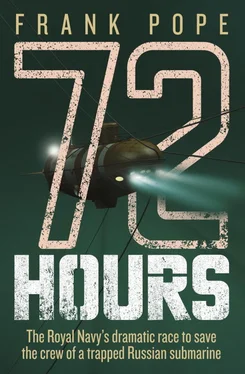With two hours to go until the C17 reached Petropavlovsk, a call came through on the radio, having been relayed from the UK by other operators. Flight Lieutenant Macintyre came to pass the message to the Navy boys in the back. He needed to stretch his legs. He was already feeling the tug of tiredness, accentuated by not having had enough rest prior to the flight.
‘Just got word that the Americans are on their way, but are an hour or so behind us. Thought you’d like to know,’ Macintyre said.
Only snoring came from the RAF side of the aircraft, but a small cheer went up from the sleepless civilian rescue team. Macintyre made his way back to the cockpit and reported to the other pilots that they looked pretty glum.
The pilots, on the other hand, were enjoying themselves. They were about to do what few RAF or USAF aircraft had done – land at a Russian airbase. Although their aviation charts were far from accurate, the Russian air traffic controllers whose zones they were flying through all knew who they were, and did not seem bothered by the fact that the RAF flight was constantly having to estimate when zone boundaries were being crossed, rather than calling with the precision usually expected of aviators.
An hour out of Petropavlovsk, Squadron Leader Hewitt asked Elizovo ATC three times to confirm their last transmission, before turning to the other pilots.
‘Elizovo ILS is down,’ he said flatly.
The others turned to look at him, to check he wasn’t messing with them. As one, they realised he wasn’t. The Instrument Landing System was their only crutch in making the decision to go ahead without a diversion airfield. If they got there and the weather was terrible, they’d have no way of accurately guiding themselves to the airstrip.
‘Are they hoping to fix it?’ one asked.
‘It’s been out of action for days, they say. So I doubt it. Cloud base is at 3,000 feet. They’re advising NDB.’
Every pilot learns how to home in on an airfield’s Non Directional Beacon, but very few ever use it again after that. The technology had hardly changed since the Second World War. The wobbling needle of the NDB gauge was squeezed in towards the edge of the C17’s instrument panel more because of historical precedent and inherited legislation than by necessity. The instrument was the same as could have been found beneath the windshield of a Spitfire 60 years before. Once you were within around ten miles of the airfield it could give a rough bearing, but that was it; because the NDB couldn’t give the range, navigating with one meant making calculations using a stopwatch. But Second World War pilots had managed to guide themselves home through fog with the NDB system, so it was possible. And while those pilots had had the advantage of familiarity with their destination, their home airfield, Hewitt’s crew had the advantage of their Global Positioning System. Although often used, GPS was not certified for use in aircraft navigation by authorities – it was still classed as experimental. In the same way as the loadmasters had been forced to go back to basics while loading the aircraft in Prestwick, running centre-of-gravity calculations from scratch, the pilots were being forced to reacquaint themselves with how to use an NDB beacon.
Two hundred and sixty tonnes of the very latest in Western military hardware were now hurtling towards Russia’s Elizovo airport at 500 miles an hour, into a black hole where normally critical elements of their aircraft’s technology were useless. The pilots had no idea how much they could trust the expertise of the Russian Air Traffic Control personnel to guide them in, so the entire descent and approach now had to be planned out by the crew themselves, using whatever they had at hand.
Over the Sea of Okhotsk, Ascot 6564 passed its point of no return. There was now no longer any option but to land at Elizovo airport. If the weather was too bad to allow landing, the aircraft would have to circle the runway and hope for a break in the cloud. If nothing had cleared in two hours, then the aircraft would be forced to ditch.
Hewitt glanced around at his three fellow pilots. They were all feeling less than fresh. Ten and a half hours of continuously recalculating diversions and fuel performances had taken their toll, along with trying to estimate control zone boundaries and the challenge of deciphering the radio calls from Russian air traffic controllers. English might be the language of international aviation, but out over the wilds of Siberia it seemed that a new dialect was evolving.
By all their calculations, they were in the right place. All of them had been trained not to trust GPS for navigation, but it was a comfort that the multi-coloured readout also showed them where they should be. Everything seemed right, but beneath his cool, collected exterior all of Hewitt’s senses were screaming caution. The enormous Globemaster was sinking fast towards the carpet of cloud that stretched in front of them. Piercing the whiteness like blackened teeth, the tips of Petropavlovsk’s 13,000-foot volcanoes were smoking. They’d last erupted 15 years before (and would again three years later in 2008), but for now the lava was not flying. But rock didn’t need to be molten and hurtling through the air to cause them trouble. A cloud unexpectedly filled with cold, hard granite was similarly effective. Hewitt was having to take it on trust that the airfield was where it said it was and that the terrain had been accurately surveyed, and it didn’t feel good.
Elizovo Air Traffic Control now said that cloud base was at 500 feet above ground level. That meant a 10,000-foot descent through cloud before popping out and finally getting visual contact with the runway. Only then would Hewitt breathe more easily. Until that point everything was theoretical. Aviation charts and flight computers didn’t show rogue vehicles crossing the strip or other aircraft taxiing lazily across it. Coming in on a precision approach, that moment of clarity could occur just ten seconds before landing, 200 feet above the ground, only two thirds of a mile from the runway threshold. But without an operational ILS he needed twice that. He’d have to break cloud 450 feet above ground, a mile and a half away from the strip, in order to be sure his approach was good.
On the plus side, Elizovo strip was 3,400 metres long, enough to take a fully laden 747. Even at maximum weight, thanks to the ability to reverse the thrust of its engines, the C17 would only need around 820 metres, and by now almost all of its weighty fuel had been burnt.
It was raining, Air Traffic Control said, and the light was beginning to deteriorate. Hewitt’s one consolation was that they had now located a military airfield on the southern Siberian coast where the weather was passable. It was the diversion they’d been searching for all along, close enough for them to be able to run one trial approachat Petropavlovsk, abort and still reach a safe haven. It would be the end of the British rescue mission, but at least the disaster would not be compounded with a wrecked transport aircraft and its human cargo.
Hewitt had programmed the C17’s flight computer to guide the aircraft on to its final approach, and was now in the hot seat as the pilot in command. He watched the sweep of the ground radar as it illuminated large swathes of high ground ahead. There was a calm silence on the flight deck. All four of the men were methodically scanning the screens and gauges, watching for the first sign of trouble.
Suddenly a red light started flashing on the instrument panel, accompanied by a sharp buzz. The autopilot had disconnected itself. Hewitt cursed. Something had gone wrong in programming the approach. Almost immediately afterwards, Elizovo ATC started talking them in, reading off their approach heights. While one of the co-pilots started trying to trouble-shoot the autopilot programming, Hewitt concentrated on trying to decipher the air traffic controller’s incomprehensible accent. It didn’t help that the heights were being given in metres, not feet. No country in the world had decided to go metric for aviation altitude measurements except for Russia. And the C17, for all its technological wizardry, worked in feet and had no instant conversion feature.
Читать дальше












